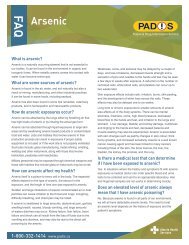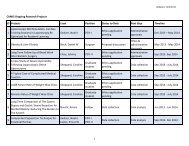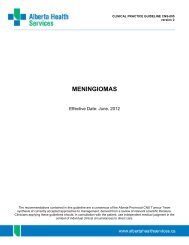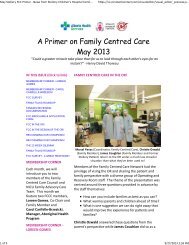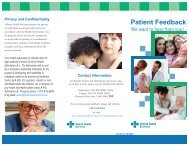EXTRAGONADAL GERM CELL TUMOURS - Alberta Health Services
EXTRAGONADAL GERM CELL TUMOURS - Alberta Health Services
EXTRAGONADAL GERM CELL TUMOURS - Alberta Health Services
You also want an ePaper? Increase the reach of your titles
YUMPU automatically turns print PDFs into web optimized ePapers that Google loves.
CLINICAL PRACTICE GUIDELINE GU-007<br />
Version 1<br />
5. Patients with mediastinal GCTs who relapse have poor prognosis. Transplant should not routinely be<br />
offered to these patients. However, depending on the results from salvage chemotherapy, patient<br />
performance status, individual factors and patient’s desire to pursue the transplant, it may be<br />
considered only after an honest discussion between the clinician and patient as the chance of long<br />
term remission and cure are very low.<br />
6. After the completion of chemotherapy, strong consideration for retroperitoneal lymph node dissection<br />
should be given in those patients with retroperitoneal primary GCTs.<br />
7. After the completion of chemotherapy, surgery to resect any residual masses should be strongly<br />
considered in those patients with mediastinal primary GCTs.<br />
Table 2. Suggested follow up schedule for germ cell tumours. 9<br />
Group<br />
Clinical examination and<br />
diagnostics<br />
Year 1<br />
Frequency of exam (months)<br />
Year 2 Year 3 Year 4 Year 5 Year 5-10<br />
LDH, AFP, HCG, clinical exam<br />
3 3 3 3 3 6<br />
good<br />
prognosis<br />
X-ray of the chest or CT scan of<br />
chest (if supradiaph. disease)<br />
3-6* 4 6 6 6<br />
CT scan of the abdomen/pelvis<br />
3 4 6 6 6<br />
LDH, AFP, HCG, clinical exam<br />
3 3 3 3 3 6<br />
intermediate<br />
and poor<br />
prognosis<br />
X-ray of the chest or CT scan of<br />
chest (if supradiaph. disease)<br />
CT scan of the abdomen/pelvis<br />
3-6*<br />
3<br />
3-6*<br />
3<br />
4-6*<br />
4<br />
6<br />
6<br />
6<br />
6<br />
* depending on the presence of intrathoracic disease<br />
DISCUSSION<br />
Diagnosis<br />
Data from an international series of 635 patients with extragonadal GCTs (54% had mediastinal primary<br />
GCTs and 45% had retroperitoneal primary GCTs) who were treated from 1975 to 1996 at 11 cancer<br />
centers was analyzed. 5 The most common symptoms at initial presentation in patients with mediastinal<br />
GCTs included dyspnea (25%), chest pain (23%) and cough (17%), fever (13%), weight loss (11%), vena<br />
cava occlusion syndrome and fatigue or weakness (6%). For patients with retroperitoneal primary GCTs,<br />
most common symptoms were abdominal-related (29%) and back pain (14%), followed by weight loss<br />
(9%), fever (8%), and vena cava or other thrombosis (9%). 2,5 Around 50-75% of patients with nonseminoma<br />
extragonadal GCTs have elevated AFP and iso-chromosome i12p. 5,6,10 Approximately 40% of<br />
patients with mediastinal seminoma and non-seminoma and those with retroperitoneal seminoma have<br />
elevated hCG. 5,6 A higher average percentage (about 70%) of patients with retroperitoneal non-seminoma<br />
present with elevated hCG levels. 6 Patients should be classified and treated based on prognosis. 1<br />
Management<br />
Chemotherapy<br />
All patients presenting with extragonadal germ cell tumours should be considered for enrollment in clinical<br />
trials. Bleomycin, etoposide and cisplatin (BEP) or etoposide, ifosfamide, cisplatin (VIP) is recommended<br />
as first-line chemotherapy, with the number of cycles given based on risk category. The recommendation<br />
Page 4 of 8



